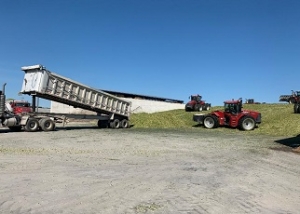News
Facility Focus: Summer Silage Storage and Bunk Management

To help prevent spoilage and feed shrink this summer, Liz Binversie and Matthew Lippert, extension agents for the University of Wisconsin, recommend the following tips.
SILAGE STORAGE
“Producing aerobically stable silage requires a combination of adequate harvest and storage management, as well as good feed-out practices,” the duo state. “Removal of oxygen through adequate packing and sealing is essential for silage preservation. Adequate packing density also improves fermentation and reduces storage losses. Poor packing will retain more oxygen within the silo [or bunker] and lead to poor aerobic stability at feed-out.”
CHECK PLASTIC REGULARLY
While little rips or tears in silage bags or bunker plastic may not seem like a big deal, they can lead to big consequences. Tears and holes in the plastic expose the feed to oxygen, which escalates to feed spoilage. Binversie and Lippert recommend checking plastic regularly and repairing holes as soon as possible. Determining the damage’s cause can also be helpful to prevent future tears.
REMOVE ENOUGH FEED TO PREVENT SPOILAGE
“There are some best management practices we can use to help keep feed fresh, especially as the heat outside increases. One of those is to remove enough feed so that we prevent spoilage. At the same time, we don’t want to remove too much feed and have that sit on the ground and also spoil. So, it’s getting that kind of happy medium,” Binversie shares.
According to Binversie, research from the University of Wisconsin-Madison has shown that removing 12 inches of silage during the summer months from the silage face is a good recommendation. It’s also important to avoid removing too much plastic during warm weather as this allows air to penetrate further into the silage.
USE A FACER INSTEAD OF A BUCKET
“Use a facer instead of a bucket when removing silage,” Binversie shares. “There’s two full reasons why we want to do this. The first is we get a much flatter face at that bunker, so we have less air that’s hitting that feed and spoiling it. The second is we have a reduced risk of having overhangs and safety issues.”
CONSIDER ADDITIVES AND MONITOR FEED INGREDIENTS
Certain feed ingredients tend to spoil more quickly as the thermometer climbs. Wet brewer’s and wet distiller’s grains are prime examples, as they can have high yeast counts. Lippert suggests taking a look at your ration and talking with your nutritionist to see if any of these ingredients could be excluded during the summer.
“Another thing you can do is purchase products that will acidify or stabilize your TMR mix,” Lippert says. “When applied to the TMR, these products have the potential to inhibit yeast proliferation and improve TMR stability. So, if you’re facing a problem that you can’t address any other way, it adds expense to your ration, but there are things you can do to bring costs down.”
BUMP UP FEED FREQUENCY
During the hottest part of the day, cows tend to eat less and put their focus on staying cool. Therefore, it may be necessary to reconfigure feeding times to better accommodate a cow’s schedule.
“Some things to look at are when you’re actually feeding out is to possibly make smaller batches and feed more frequently during the day,” Lippert says. “Plan when to feed the herd so it coincides with when cows are most likely going to eat. Early morning and later in the evening are better times to feed to take advantage of when cows are cooler and more comfortable. Similarly, you could consider pushing feed up, feeding more during these cooler times of the day, and less during peak temperatures.”





















